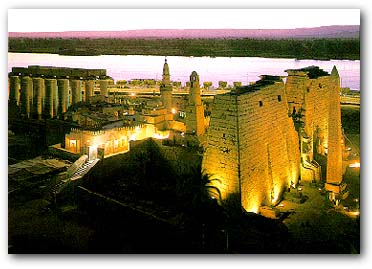| The Temple of Luxor  Amenhotep III and Ramesses II, it appears
that the temple's purpose was for a suitable setting for the rituals of the festival. The festival
itself was to reconcile the human aspect of the ruler with the divine office. During the 18th
Dynasty the festival lasted eleven days, but had grown to twenty-seven days by the reign of
Ramesses III in the 20th Dynasty. At that time the festival included the distribution of over
11,000 loaves of bread, 85 cakes and 385 jars of beer. The procession of images of the
current royal family began at Karnak and ended at the temple of Luxor. By the late 18th
Dynasty the journey was being made by barge, on the Nile River. Each god or goddess was
carried in a separate barge that was towed by smaller boats. Large crowds consisting of
soldiers, dancers, musicians and high ranking officials accompanied the barge by walking along
the banks of the river. During the festival the people were allowed to ask favors of the statues
of the kings or to the images of the gods that were on the barges. Once at the temple, the king
and his priests entered the back chambers. There, the king and his ka (the divine essence of
each king, created at his birth) were merged, the king being transformed into a divine being.
The crowd outside, anxiously awaiting the transformed king, would cheer wildly at his
re-emergence. This solidified the ritual and made the king a god. The festival was the
backbone of the pharaoh's government. In this way could a usurper or one not of the same
bloodline become ruler over Egypt. Amenhotep III and Ramesses II, it appears
that the temple's purpose was for a suitable setting for the rituals of the festival. The festival
itself was to reconcile the human aspect of the ruler with the divine office. During the 18th
Dynasty the festival lasted eleven days, but had grown to twenty-seven days by the reign of
Ramesses III in the 20th Dynasty. At that time the festival included the distribution of over
11,000 loaves of bread, 85 cakes and 385 jars of beer. The procession of images of the
current royal family began at Karnak and ended at the temple of Luxor. By the late 18th
Dynasty the journey was being made by barge, on the Nile River. Each god or goddess was
carried in a separate barge that was towed by smaller boats. Large crowds consisting of
soldiers, dancers, musicians and high ranking officials accompanied the barge by walking along
the banks of the river. During the festival the people were allowed to ask favors of the statues
of the kings or to the images of the gods that were on the barges. Once at the temple, the king
and his priests entered the back chambers. There, the king and his ka (the divine essence of
each king, created at his birth) were merged, the king being transformed into a divine being.
The crowd outside, anxiously awaiting the transformed king, would cheer wildly at his
re-emergence. This solidified the ritual and made the king a god. The festival was the
backbone of the pharaoh's government. In this way could a usurper or one not of the same
bloodline become ruler over Egypt.
The Pylons
The Court of Ramesses II
The Mosque of Abu'l Haggag
The Court of Amenhotep II
|





